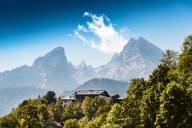
The mighty Watzmann in the background, a town centre with medieval buildings: Berchtesgaden in Bavaria is a worthwhile destination for a day trip from Munich - in every respect. The most famous sights include the Berchtesgaden salt mine and the Royal Palace. Not far from Berchtesgaden, visitors will find the Obersalzberg Documentation Centre, the Eagle's Nest and Lake Königssee.
- Sights in Berchtesgaden: Royal Castle
- Obersalzberg and Eagle's Nest: Berchtesgaden's dark past
- Excursions from Berchtesgaden - from Königssee to the salt mine
- Berchtesgaden: How to get there from Munich
- Frequently asked questions about Berchtesgaden
The town is one of the most popular holiday destinations in Bavaria, where visitors can stroll around the historical market surrounded by beautiful townhouses, buy mementoes in tiny stores, and relax in the cosy cafés or distinctively Bavarian taverns. One of Berchtesgaden’s most famous sights is the Collegiate Church of St. Peter and St. John the Baptist at the Augustinian monastery, which has a three-aisled Gothic nave at its heart, a twin-towered façade which dates from the Romanesque era, and an early Gothic choir, built between 1283 and 1303, which is a particular attraction.
Berchtesgaden Royal Castle was also built by the Augustinians in the Middle Ages. Its late Romanesque cloister reflects the era in which it was built – though after secularisation took hold in the region, the ruling Wittelsbach family used it as a hunting lodge. The castle, with its many works of art including two altarpieces by Tilman Riemenscheider (dating from around 1500), can only be visited as part of a guided tour.
The Dokumentation Obersalzberg (documentation centre) is also well worth a visit. This historical centre hosts an exhibition detailing the story of Obersalzberg and the National Socialist dictatorship – Hitler bought his Berghof mountain residence in the area, and spent much of his time there during the war. In fact, after 1933, Obersalzberg was a second centre of power during the Third Reich. From the Obersalzberg documentation centre, you can take the bus along the Eagle's Nest Road up to the Kehlsteinhaus (Eagle's Nest), which offers a unique view over the Berchtesgaden and Salzburg regions.
The Kehlsteinhaus, or ‘Eagles Nest’, situated at an altitude of 1834 metres, was little used by Hitler and was spared from the bombing at the end of the war, along with parts of its dreary 1930s interior. Its location with a view of the Watzmann and Königssee was intended to impress foreign guests of state. Today, most people combine a visit to the documentation centre with an ascent to the Eagle's Nest. However, this is only possible from the beginning of May to the end of October.
You can also combine a visit to Berchtesgaden with a ‘SalzZeitReise’ (SaltTimeTravel) underground in the Salzbergwerk Berchtesgaden (salt mine). Of course, it is also possible to make a detour to Königssee and take an electric boat to St. Bartholomä or even further to Salet at the end of the approximately eight-kilometre-long lake. If you want to find out more about the Berchtesgaden National Park around Königssee and Watzmann with its flora and fauna, the Haus der Berge is the right place for you. The information and education centre is located at the entrance to Berchtesgaden with an unobstructed view of the Watzmann.
The city of Munich offers guided tours with a professional tour guide: The day trip from Munich takes visitors along the German Alpine Road to the marvellous Berchtesgadener Land. In addition to spectacular views, the tour also explores the dark history of this region. The excursions currently take place twice a week and can be booked here.
Train connection: about 2 hours. More information under bahn.de
Car: about 2 hours via the A8 motorway